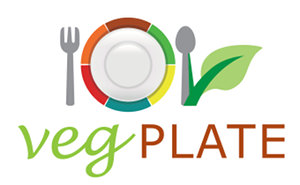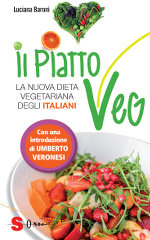
The VegPlate: What is it and Who Needs it
What is the VegPlate?
The VegPlate is a collection of indications and suggestions to set up an optimal diet for your health, based on plant foods.

In the past, the rules for a healthy diet used the "food pyramid", in its various representations: in layers, wedges, etc. Today, the most up-to-date representations (such as the US Government's "My Plate", the "Power Plate" of the American Doctors for Responsible Medicine - PCRM, etc.) are based on the "dish", which depicts the various food groups in the form of wedges.
In 2015, the VegPlate replaced the already known VegPyramid, with the latest data from the new international and national nutrition recommendations.
It is important to note that the VegPlate does not contain specific "prescriptions" for vegetarians to avoid "deficiencies" with respect to the widespread omnivorous diet. On the contrary, a plant-based diet is certainly healthier than one based on animal foods, for which fear of damage from improper nutrition is more motivated when following today's average Western diet.
Rather, the VegPlate indications are intended for those who want to use their diet as a means to personally deal with their health: as prevention against the development of chronic diseases, and as a way to ensure daily well-being and health. Thus, from this point of view, they serve all individuals: not only vegetarians but also, and above all, who is still an omnivore, because in either case a healthy diet is based on plant foods, as all international guidelines point out.
Following the advice of PiattoVeg, you can plan an optimum diet based precisely on plant foods, the healthiest and most suited for the human organism. The higher the proportion of plant foods, the greater the benefits, with a 100% vegetable diet giving the greatest benefit. With greater reason, who is still an omnivore, can benefit from the advice of VegPlate: starting to decrease the consumption of meat, fish, dairy products and eggs in favor of plant foods, learning about what they are, how to use them and their advantages. Even beginning with just 3-4 days a week of VegPlate's recommendations, and then increasing the number.
Furthermore, it is necessary to understand that following the indications of VegPlate doesn't mean having to weigh each single food and follow iron-clad rules, as though the person were on “a diet”. It means instead, understanding what the healthier kinds of foods are to eat each day (all of them divided in 7 food groups), what the optimal proportions are (in order to avoid, for example, eating too little vegetables or too much fruit, fats or carbohydrates) and the adequate quantities for one's own lifestyle.
Remember that the basic rule is VARIETY: a varied 100% vegetable diet, that includes all food groups, using different foods within each group, is what gives healthfulness, helps in the prevention of chronic diseases, and also gives the pleasure of good food.
Don't forget also that the practice of regular physical activity, taking abundant amounts of fluids, and exposure to the open air and sunlight, are other important lifestyle habits that favor physical well-being and health maintenance.
How VegPlate Works
The crucial point for using the VegPlate indications is to understand the concept of a "serving": VegPlate, as did VegPyramid as well, indicates for each food group the optimum number of "servings" to be consumed in a day as the energy requirement (i.e. the amount of calories to consume, which varies according to age, gender and physical activity). "Serving" does not mean a subjective quantity, but a precise value in grams, which is different for each type of food.
As a practical example for a day's grains quantity, if the optimal amount of servings of grains is 10, this doesn't mean you have to eat 10 plates of pasta! Furthermore, the concept of "pasta" is subjective, too: it can contain 70, 80, 100 or even more grams, depending on the habits of the individual. On the contrary, a serving of grains, in VegPlate, is a well-defined quantity: 30 grams of pasta (uncooked) or rice or bread. Thus, to eat 10 portions of grains means consuming, for example: a pasta dish (90 g = 3 servings), 120 g of bread (4 servings), a rice dish (90 g = 3 servings).
Some examples of the meaning to "1 serving"
- for cereal grains and pasta, it's 30 g (uncooked)
- for legumes, it's 30 g dried legumes, 80 g cooked legumes
- for vegetables, it's 100 g raw
- for fruit, 150 g
- for oil, 5 g (1 teaspoon)
A complete servings table is available for all the food groups.
So, the first important thing to understand for each food group is the amount that corresponds to a serving; then determine how many servings of each food to which "we are entitled" within our calorie requirement; and finally elaborate our "plate" on the basis of these ingredients, creating ever-changing and appetizing recipes . After a few weeks, it will no longer be necessary to think about these quantities: you will have a “gut feeling” for the right amount of everything to eat, it will become automatic.
If we realize that one day we ate too much of a certain food and too little of another, do not worry: we will make up for it the following day! And it must always be kept in mind that not being completely "loyal" does not mean getting who knows what dangers, it just means having a diet isn't as perfect as could be the best one obtained by correctly applying all the "rules". These rules should not be a source of anxiety or concern: on the contrary, they are intended to help, a guide that allows us to get the most from the diet as a promoter of health.
Who is VegPlate for?

As already explained, it can help everyone, not only vegans and lacto-ovo vegetarians! In an omnivorous diet that follows the guidelines, 80% of the food consumed must be vegetable ANYWAY; at most 20% may not be (but if that 20% becomes 0%, so much the better, because the consumption of animal products is still harmful, even when the amount consumed is far less than the today's average).
In a diet such as that of the omnivores, where the real situation is the exact opposite, i.e., with all the damage caused to human health (lack of fiber, of various vitamins, phytocompounds, consumption too much protein, saturated fat, cholesterol, iron, etc.), learning how to set up your own diet with plant foods is like a gift that everyone can give themselves for their own well-being both now and in the long term.
Starting to use plant-based ingredients instead of animal products at least 3-4 days a week is a first step in the transition to healthier eating; until you get to 100% vegetable, the healthiest.
To begin
Begin by discovering the vegetable food groups and the benefits for your health in consuming foods that compose them.
Also, learn about diseases you can prevent with a plant-base diet and how the many available vegetable ingredients can be used in kitchen.
Enjoy your read!
VegPlate - the books

